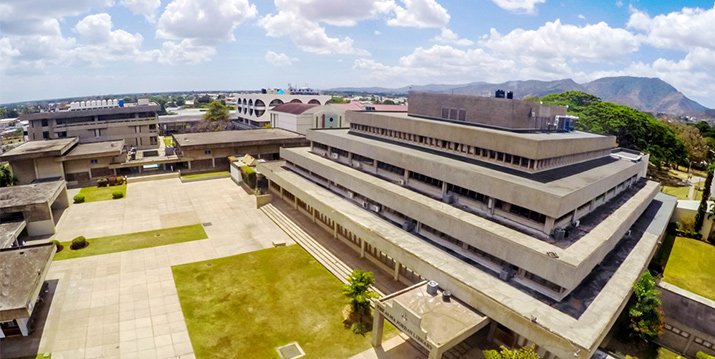The University of the West Indies (The UWI) is now among a list of the world’s top 100 Universities in new rankings released by Times Higher Education (THE).
On June 24, THE revealed its ‘Golden Age University Rankings’ of established higher education institutions across the world that have been around for 50 to 80 years. Based on years of existence, this category compares institutions established between 1945 and 1967, using the same criteria and methodology as the World Rankings. According to THE, “the ranking takes its name from what was a ‘Golden Age’ in global higher education, characterised by rapid university expansion and increasing investment in research.”
These results reinforce that in spite of being a relatively young institution, and having limited access to financial and development resources, in just over 70 years The UWI has successfully built a solid reputation as the higher education leader. Recently during the annual report presentation to its University Council, Vice-Chancellor, Professor Sir Hilary Beckles noted that the academy is among the best in the world and its reputation has never been higher. This latest top 100 ‘Golden Age’ ranking performance affirms The UWI’s prestige and leadership as it is now a familiar and consistent name in the Times Higher Education’s rankings, yet remains the sole Caribbean university on all the lists.


2 Comments
Established, and original buildings and land bought and paid for be the British government. They brought wonderful education throughout the Caribbean despite the lies that we have been told indicating otherwise.
I recently read a book which lists all the British input into Caribbean education since abolition.
From the same Book
1948, Jamaica: Education, University of the West Indies; the university was founded in 1948 by the British, on the recommendation of the Asquith Commission [1943].
Ref: http://www.bcn.cl/obtienearchivo?id=documentos/10221.1/29331/2/213787.pdf
Through its sub-committee on the West Indies chaired by Sir James Irvine [1948].
Ref: Report of the West Indies Committee of the Commission on Higher Education in the Colonies, Presented by the Secretary of State for the Colonies to Parliament by Command of His Majesty June 1945. London, His Majesty’s Stationery Office.
The Asquith Commission had been established in 1943 to review the provision of higher education in the British colonies. Initially in a special relationship with the University of London, the then University College of the West Indies (UCWI) was seated at Mona, about five miles from Kingston, Jamaica. The university was based at a camp used by evacuated Gibraltarians during the war.
Ref: Brown, |Suzanne Francis (2006). Mona Past and Present: The History and Heritage of the Mona Campus, University of the West Indies p.10-11. University of the West Indies Press. ISBN 9789766401597.
The Colonial Higher Education Commission was appointed in Aug., 1943, under the chairmanship of The Honourable Mr. Justice Asquith, “to consider the principles which should guide the promotion of higher education, learning and research and the development of universities in the Colonies; and to explore means whereby universities and other appropriate bodies in the United Kingdom may be able to co-operate with institutions of higher education in the Colonies in order to give effect to these principles.”
Ref: http://discovery.nationalarchives.gov.uk/details/r/C5147
With funds for buildings [equipment and fittings] from the British government and commitments from West Indian governments to meet recurrent expenses, such a centralized university college came to life in Jamaica in October 1948, with teaching first in medicine, followed by natural sciences (1949) and arts (1950).
Extramural staff to develop adult education and West Indian cultural activities were placed on non-campus islands, but this was not thought to detract from the principle of a centralized university. However, after about twelve years this centralized single-campus residential model was found inadequate to guarantee rapid expansion or to satisfy insular nationalistic drives to possess a part of the university. In 1960 the Imperial College of Tropical Agriculture, a tertiary-level institution in Trinidad founded in 1922, merged with the University College and became its Faculty of Agriculture.
Two years later (1962) a Faculty of Engineering, with much funding from the government of Trinidad, started at St. Augustine, and the next year (1963) teaching in arts and natural sciences commenced at St. Augustine and Cave Hill. The university had begun its journey to decentralization.
The history of the University College (which became the University of the West Indies in 1962, having claimed its independence from the University of London) may be conveniently divided into three periods: first 1948 to 1960, when it was a residential single-campus centralized University College; then 1960 to 1984, when the struggles to find a new non-residential, decentralized, multi-campus model was most pronounced; and finally 1984 to the present, when a highly satisfactory decentralized model was agreed on, first in 1984 and then refined in the mid-1990s by a new governance system. At this point, for instance, each faculty on each campus got its own dean. The university grew from thirty-three medical students in 1948 to 970 students in 1960, and despite repeated difficulties in raising recurrent financing, it did succeed largely by a mix of students from different territories in creating the West Indian outlook the Irvine Committee dreamed of. However, this outlook was subsequently impaired, though not lost, by a number of developments. West Indian leaders failed to create a national state; the Federation of the West Indies lasted only from 1958 to 1962; territorial nationalism grew; some territories, starting with Jamaica and Trinidad, became independent after 1962; and Guyana withdrew from the university in 1962. Eventually the university authorities found that instead of dealing with seven governments as at the start, they were dealing with fourteen. The university was financed for limited periods, usually for nine years at a time, and it was not until 1989 that the West Indian governments declared their commitment to keeping it as a regional institution in perpetuity. Most of the islands could not seriously think of financing their own university apart from the University of the West Indies, but two islands, Jamaica and Trinidad, because of their greater size and greater resources, talked as if they could establish their own university. The more credible threat came in the mid-1970s from Trinidad, which had surplus oil revenues. But using hindsight now it seems as if all the threats of the leading politicians were only negotiating positions in the struggle to locate faculties and programs in their territories or to have more local power over the university.
Ref: http://www.encyclopedia.com/history/encyclopedias-almanacs-transcripts-and-maps/university-west-indies
Early Education in the British Colonies of the Caribbean. See also 1834 and 1835.
Between 1830 and 1950, when the transition to independence began, there were no more than ten small colleges training teachers, five even smaller colleges training ministers of religion, a few for the preparation of nurses, and one college training agriculturalists in the entire British West Indies. Ref: Miller, 2000.
Some of the major landmark institutions that emerged to meet the demand for and to facilitate the development of higher education within the region included Calabar, a Baptist theological college, established in Jamaica in 1843; the Imperial College of Tropical Agriculture (ICTA) established by the colonial authorities in Trinidad in 1921.
Ref: Roberts, 2003. and the University College of the West Indies (UCWI), currently the University of the West Indies (UWI), established in Jamaica in 1948 as a regional institution with a mission to meet the higher education needs of the Anglophone-Caribbean and to promote regional identity.
Ref: Cobley, A. (2000). The historical development of higher education in the Anglophone Caribbean. In G. D. Howe (Ed.) Higher Education in the Caribbean: Past, present, and future directions, (pp. 1-23). Kingston, JA: UWI Press.
At the time the UCWI was founded, the chief purpose of higher education within the British Caribbean region was “to cultivate skills, dispositions and social identities consistent with the imperatives of [a] nationalistic ethic”.
Ref: Sylvester, M. (2008). The globalization of higher education: Assessing the response of the University of the West Indies. Advances in Education in Diverse Communities Research Policy and Praxis, 6, p273.
UWI currently has three regional campuses that are located in Jamaica, Barbados, 350 Educational Developments in the British West Indies: A Historical Overview and Trinidad and Tobago, University Centers in the non-campus countries (NCCs), and a Center for Hotel and Tourism Management in the Bahamas.
Ref: University of the West Indies (UWI) (2006). About UWI.
Retrieved from http://www.uwi.edu/aboutuwi/overview.aspx
Beginning in the late 1960s through the 1990s, there was a rise in the number of higher education institutions in response to the growing demands for higher education within the region. In the 1980s and 90s increased demand for higher education resulting from pressure for access by larger numbers and more diverse groups of students resulted in the emergence of new universities, multi-disciplinary colleges as well as specialized non-university tertiary institutions.
Ref: Roberts, 2003.
During the late 1960s through the 1990s, there was a rise in the number of higher education institutions within the Caribbean in response to the growing demands for higher education within the region.
Ref: Miller, 2000.
At the dawn of the twenty-first century, increased demand for higher education within the Caribbean was being met by the emergence of new universities, multi-disciplinary colleges as well as specialized non-university tertiary institutions.
Ref: Roberts, 2003.
At present higher education within the Anglophone Caribbean consists of a diverse mix of over 150 higher education institutions, approximately 60% of which are publicly or nationally funded; 30% are completely private; and 10% are privately owned but receive some government funding.
Ref: Howe, 2003.
Ref: https://files.eric.ed.gov/fulltext/ED567093.pdf
General Ref: Educational Developments in the British West Indies: A Historical Overview by Chad O. Coates.